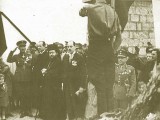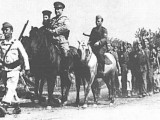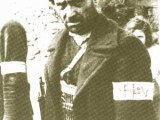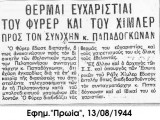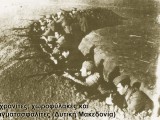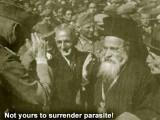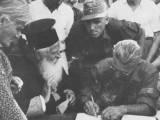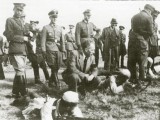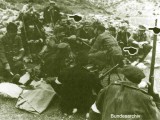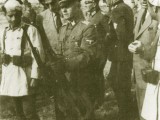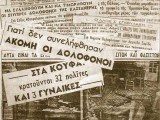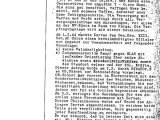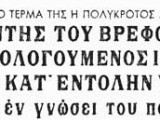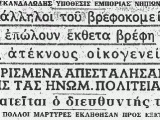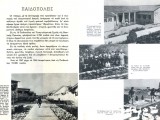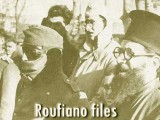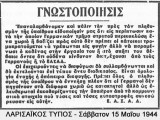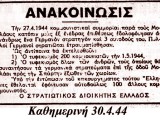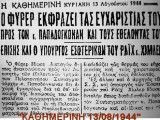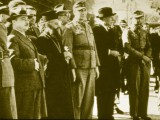ΑΜΕΡΙΚΑΝΙΚΗ ΚΑΤΟΧΗ ΚΑΙ Ο ΡΟΛΟΣ ΤΩΝ ΡΟΥΦΙΑΝΩΝ (1947-49) - English
THE AMERICAN OCCUPATION OF GREECE AND THE ROLE OF 'REFORMED' NAZI COLLABORATORS (1947-1949)
The original article lies between the horizontal lines. Highlighting in red is by the webmaster and not the author.
.
PART ONE: Cold War and Special Warfare
1. Interest, Intervention, and Containment
...
The Cold War Begins
The Greek Civil War of 1946-1949 has been characterized as "the formal proclamation of the cold war" between the "Free World... and the forces of communism."27 The U.S. intervention in the civil war was the first counterinsurgent campaign of the Cold War. The U.S. Army Group Greece (USAGG) was established as part of the American Mission for Aid to Greece on 14 April 1947. The Aid to Greece and Turkey Bill, Public Law 75, the fruit of Truman's "containment" speech, authorized what was then the War Department to send military advisers to Greece, and required of Greece free access to U.S. personnel. The first personnel of USAGG, intended primarily to assess military assistance needs, reached Athens on 24 May, with a complement of forty military and twenty civilian personnel in place by 31 July. The first shipload of American military supplies arrived on 2 August. The USAGG was replaced by a full military advisory establishment, the Joint United States Military Advisory and Planning Group (JUSMAPG) on 31 December 1947. From that time, U.S. Army advisers went into the field with combat forces with a mandate to provide "aggressive assistance in the form of operational and logistic advice."28
The actual numbers of Americans involved on the ground in the Greek Civil War were not released to the public or to Congress at the time. Moreover, a 1961 White House paper on the Greek conflict, prepared for President Kennedy as a case study on counterinsurgency, suggests a deliberate concealing of the level and intimacy of American a military involvement.''29 The State Department's second report to Congress reported that the Mission to Greece itself had grown within two years to over "100 military personnel, 220 civilians in the economic mission, 100 diplomatic and intelligence officers," and 80 administrative officers.30" The 1961 White House report gave rather larger figures, reporting personnel levels at the peak period at about 1,500, some 800 of whom were military personnel attached to the military mission. The same report quantifies assistance by the United States as having totalled $723.6 million ($198.4 military) "for the critical years 1946-48 and an additional $362 million ($158.7 military) for 1949," although the exact proportion of military to economic aid was unclear: "It is very difficult, however, to state just what resources we contributed, or how much economic aid was devoted to counter-guerrilla activity."31
The 1961 report stressed as essential to the campaign's success the almost total command of the operation by Americans and the presence of advisers on combat operations conditions that would remain at the top of the agendas of American counterinsurgents from Vietnam to El Salvador. Although JUSMAPG was originally limited to supply and training in the use of new weaponry, under General James Van Fleet, appointed to head the military group in February 1948, "its mission was broadened to include training and operations."32 As one analyst has observed, Van Fleet became "the de facto senior tactical officer of the Greek National Army," with the American military group "insisting that all its recommendations be carried out fully and speedily."33 Another lesson drawn by Kennedy's counterinsurgency advisers from the Greek intervention was that U.S. combat troops were not committed and that "only three U.S. military personnel were lost during the campaign.34
The Greek armed forces in early 1948, as the American military mission began operations, numbered some 120,000 and were organized in a combination of conventional and mountain infantry divisions, British organized commando Wits (known by their Greek initials as LOK), and territorial forces known as the National Defense Corps (sometimes called National Guard).35 A National Civil Guard had been set up immediately after the fall of Germany but had been replaced by a national police force (or gendarmerie) in November 1945.36 The gendarmerie, which operated in all areas except large towns that had their own police services had, at war's end, some 20,000 men but "had fallen into disrepute through continuing to function under the German occupation authorities."37 A British Police and Prisons Mission took charge of the "purification" of the force: Within a month of the British landings, the "reconstituted" - but largely unchanged - gendarmerie was fully operational.38 The reorganization of the Greek army was considered complete by May 1948. Force levels rose to some 145,000 regulars in 1949.39
The American military strategy was largely conventional: to pin down Democratic Army forces with massed troops and overwhelming firepower, and systematically to clear the adversary from mountain redoubts. Commando forces some 2,000 men in all were reserved for "raiding, deep penetration patrolling and as an air mobile strategic reserve."40 Massive operations in 1948 combined artillery and airpower (including strafing, high-explosive bombardment, and napalm) with infantry sweeps. Air power in Operation CROWN, a June-August 1948 offensive against Democratic Army forces in the Grammos Mountains, involved the "not-always-Greek pilots of the Greek Air Force" in over 2,400 offensive sorties as well as 750 reconnaissance and 180 supply missions.41
The counterinsurgency campaign included some aspects that would become familiar in later campaigns (and which had antecedents in British and French colonial doctrine, and in the United States' own experience as a neo-colonial power). Most significant of these was the forcible relocation, or clearance of the population from certain areas to create a "no-man's-land." British counterinsurgent Edgar O' Ballance described the measure:
Under American insistence energetic counter-measures were taken... and one of the most effective of these was the systematic removal of whole sections of the population. This was more far-reaching than is usually realized. It removed the people, it demarcated a "front line", it prevented "back infiltration" and it caused a blanket of silence to descend. Without to support and succor him, the guerrilla is a fish out of water; he might as well be fighting in a foreign and hostile country.42
A second innovation was the system of the Greek National Defense Corps, a kind of territorial militia organized for defense duties at the local level: As a classic example of counter-organization for counterinsurgency, its recruitment criteria were political. The militia armed and mobilized population sectors predisposed to combat real or suspected communists. The system evolved from an earlier right-wing paramilitary force which was based largely on the wartime Greek Democratic National League (EDES). This had been a principal vehicle of the "White Terror" of 1946-1947, and the disbanding of the ad hoc "home guard" was a principal demand of the Left prior to the outbreak of open civil war.43 A 1947 New York Times article reported the creation of the new force in the context of Prime Minister Sophoulis's September 1947 pledge to call a "national rally" to "exterminate" the guerrillas if they did not hand in their arms.44 "Exterminating guerrillas," however, was "one of the most difficult assignments an army can have..." The new program would combine local paramilitary forces at the grassroots with mobile regular units:
Everyone now seems to agree that the army should use guerrilla methods, but little has been done to implement the idea. One thing that has been done, however, is to begin organizing a National Guard composed of reservists. Thirty-five to forty battalions of 500 men each will take on static defensive duties in endangered areas and release regular troops for offensive operations. The guard will replace... an unpaid, ill-equipped home guard recruited among Right-wing elements which frequently compensated for its military ineffectiveness by persecuting so-called Communist villagers. The American Mission for Aid to Greece... views the National Guard plan with favor.45
The National Defense Corps was established in October 1947, its force level authorized initially at 20,000 and raised to 50,000 in January 1948. The force was to be under army command, with active-duty army personnel serving as trainers; its recruits were to be veterans of military service, and were to serve on a part-time basis in their home areas while living at home. A Marine Corps Gazette study described the theory as that of "minutemen", a militia that could protect the civil community in general, providing local patrols and serving on guard duty and free the army for the pursuit of the guerrillas.46 Although the force level eventually reached some 50,000, the same source observes that "the 'minuteman' function was gradually abandoned" as these reserve units were called up to serve as conventional light infantry battalions.
The paramilitary militia system persisted after the collapse of National People's Liberation Army (ELAS) forces in 1949, to be cited later by U.S. counterinsurgents as a model for the "counter-organization" of the civil population for grass-roots population control and counter-guerrilla action. Lt. Col. John McCuen, in The Art of Counter-Revolutionary War (1966), cites the post-war incarnation of the National Defense Corps (Tagmata Ethnikes Asphaleias) as a model for local self-defense, military training, and political indoctrination: "We have had few near-ideal examples of effective counter-revolutionary strategy, but the TEA organization is one of the best. It seems worthy of close emulation by other countries threatened with revolutionary action."47
A key characteristic of the system was the interpenetration and close control of the system by the regular army,48 a shared feature of later paramilitary systems such as El Salvador's ORDEN and the civil self-defense organizations set up in Latin America, Vietnam, and the Philippines since the early 1960s. The TEA's model recruitment procedure again similar to that of El Salvador's ORDEN and current civil defense systems employed a system of vetting personnel according to their political proclivities and of keeping costs down: remuneration came in the form of patronage jobs and surplus commodities.49 The incorporation of ex-conscripts into the system provided a means of taking advantage of military training in the long-term, as well as retaining a means of ongoing supervision of trained personnel.
The political dimension went beyond recruitment criteria; although a form of active military reserve, TEA also had the characteristics of a paramilitary political organization:
A significant element of the TEA training is political as part of the Greek Army's "enlightenment" campaign. Officers get special courses to prepare them for this responsibility. Not only do the officers indoctrinate their men, but they often travel through their areas of responsibility giving speeches to the villagers... As a result the Greeks look upon the TEA organization as an important means of influence, commitment, and control of the population.50
At base, however, the political role was superimposed on a political-policing role of intelligence, vigilance, and repression. TEA units were armed with rifles, submachine guns, and light machine guns (kept locked up by officers), and they carried out guard and patrolling functions in rotation.51
In late 1948, the Democratic Army leadership changed from a strategy of guerrilla warfare to employ the conventional tactics of open confrontation and battle in an apparent move to achieve a victory before the inflow of American arms could turn the tide (or the Tito-Stalin rift led to a total rupture between its leaders and Yugoslavia, which had hitherto provided sanctuary). The strategic shift proved catastrophic. In a final campaign in August 1949, the Democratic Army confronted the national army's combination of infantry, artillery, and air power "in heavy, positional combat" in the Grammos and Vitsi ranges, and after six days of fighting it was routed.52 Although many guerrillas fled across the border into Albania, the military victory effectively ended the Greek Civil War.
The 1961 re-examination of the Greek campaign for the Kennedy White House summarized factors in the Greek conflict considered to bear on contemporary counterinsurgency. 53 The report very much shared the American view held in 1948: The guerrilla Democratic Army was a straightforward extension of Soviet power, and cutting the Democratic Army off from sanctuary and resupply had proved decisive in its defeat.54 Attributing the military defeat of the Democratic Army to the closure of the Yugoslav border, however, ignored Albania's uninterrupted supply and sanctuary role. And, as Larry Cable notes, cross-border traffic into Yugoslavia remained partially open until duly 1949, "less than a month before the insurrection was finally suppressed." 55
The 1961 paper provides insight into the way insurgency was seen at the time. Although called a "civil war", the American view of the Greek conflict in 1949 was that of "a partisan war in which [the Democratic Army] operated as auxiliaries of the Soviet Army whose intervention was possible and, for a while, seen as probable." The view then was that a guerrilla movement could not represent a serious threat in the absence of the conventional forces of an external sponsoring power. The non-military aspects, however, from civic action to the forced relocation of civilians were fully noted and seen as integral parts of the counterinsurgency campaign. Population control measures, in particular, were seen to have been successful, in part because the "protection or removal to positions of safety of exposed Greek civilians" gave them "the courage to resist the guerrillas." The conclusion was that earlier support for the guerrillas "was largely a result of fear".
The events in Greece tended to reconfirm wartime perceptions of guerrillas as partisans attached to contending powers and insignificant without outside support. The conversion of Colonel Zervas's EDES collaborationists (and Zervas himself) into American allies in turn reaffirmed American military views that (non-communist) partisans, however unsavory, could be brought to heel and used to good effect by the United States whether in offensive unconventional warfare or in counterinsurgency warfare.
Although the Greek conflict was outstanding for the level of atrocities committed by both sides, the element of terror was downplayed by the American military in its later analyses of the conflict. Rather, the consensus was that victory resulted largely from the combination of conventional military tactics with the kind of "firm but fair" policies associated elsewhere in Europe with American occupation forces, and, perhaps decisively, the isolation of the guerrillas from their foreign sanctuaries. An August 1966 Military Review, however, reflected later thinking by describing the Greek conflict "the Anti-Bandit War" as the first step toward the aggressive and innovative counterinsurgency strategies of the 1960s:
From the military point of view, it established four significant trends in US strategy:
*
The provision of large-scale military assistance to a foreign government in "peacetime".
*
The use of US military personnel as advisors to indigenous forces in the conduct of active military operations.
*
The development of counter-guerrilla tactics as a paramount requisite of the cold war.
*
The acceptance of US involvement in military hostilities without the commitment of maximum resources.57
...
1.
Admiral Alfred T. Mahan, The Interest of America in International Conditions, quoted in Charles Beard, The Idea of National Interest: An Analytical Study in American Policy (New York: Macmillan, 1934), p. 2.
2.
National interest in Mahan's writing cloaked realpolitik with the impersonal virtue of obligation and natural law, much as the Social Darwinists of the positivist school made a virtue of the domination of the "weak by the strong " on "scientific" grounds of evolutionary law.
3.
What became known as the "Roosevelt Corollary" of the Monroe Doctrine was based on Roosevelt's 1905 statement to Congress in the course of a debt crisis then in progress in the Dominican Republic. The threat of intervention by European creditor powers was to be opposed under the Monroe Doctrine's "hands off" policy; according to Roosevelt, the United States was obliged to intervene when its neighbor republics failed to live up to certain standards. Those countries that showed they "know how to act with decency . . . need fear no interference Tom the United States . . . I but] brutal wrongdoing, or an impotence which results in a general loosening of the ties of civilized society, may finally require intervention by some civilized nation, and in the Western Hemisphere the United States cannot ignore this duty." See Hubert Herring, A History of Latin America (New York: Alfred A. Knopf, 1968), pp. 911-12.
4.
Beard, Idea of National Interest, p. 3, citing A. T. Mahan, The Problem of Asia, p. 97.
5.
N. Gordon Levin, Jr., Woodrow Wilson and World Politics: America's Response to War and Revolution (London: Oxford University Press, 1968), p. 7.
6.
See Levin, Woodrow Wilson, p. 18, for Wilson's speech to a Salesmanship Congress in Detroit toward the end of his first term: "[Y]ou are Americans and are meant to carry liberty and justice and the of humanity wherever you go, go out and sell goods that will make the world more comfortable and more happy, and convert them to the principles of America. "
7.
" 'Statement of US Overseas Internal Defense Objectives' from the Deputy Assistant Secretary of State for Political Military Affairs (Mr. Jefferey C. Kitchen) to the Deputy Assistant Secretary of Defense for International Security Affairs (Mr. William P. Bundy'' (undated)' in Willard F. Barber and C. Neale Ronning, Internal Security and Military Pourer: Counterinsurgency and Civic Action in Latin America (Columbus: Ohio State University Press, 1966), Appendix B. A 1962 class)fied (secret) statement of "US Overseas Internal Defense Policy" (see chapter 6, "Policy into Doctrine") is considerably different in content (from John F. Kennedy Library, National Security Files, Box 338, NSAM 182). The counterinsurgency dimension of Walt W. Rostow's stages of economic growth is discussed in the same section.
8.
Levin, Woodroe]w Wilson, pp. 70-72. The foundations of an American policy took form Ul a series of memoranda prepared by State Department Russian expert Basil Miles between 28 November 1917 and February 1918 "which combined a . . . desire to control Bolshevism by reintegrating into a liberal Russian consensus with a . . . tendctlcy to make explicitly clear that a purely Bolshevik regime in Russia was morally and politically unacceptable to America." Miles's memoranda were remote ancestors of George Kennan's famous "Mr. X" memorandum on the post World War 11 Soviet threat, "The Sources of Soviet Conduct" (see p. 9 ).
9.
The Siberian intervention remains an episode of interest to the United States (as no doubt the Soviet) military establishment to date. A 1984 article in the U.S. Army's Military Review discussed the Siberian intervention as an early example of the deployment of U. S. military forces with an explicitly political_not military_task to perform (Captain Judith A. Luckett, "The Siberian Intervention: Military Support of Foreign Policy," Military Review [April 1984]). Of particular interest was the reluctance of the commander of the force, General William S. Graves, to work in concert with White Russian forces_on human rights grounds: "My beliefis that the people in Eastern Siberia have no confidence in Kolchak, representatives here.... I have absolute proof that Ivanoff's troops have tortured, killed and robbed people...."
10.
George F. Kennan in his "Mr. X" article, "The Sources of Soviet Conduct, " Foreign Affairs 25.4 (duly 1947), pp. 566-82; reprinted in Kennan, American Diplomacy 1900-1950 (Chicago: University of Chicago Press, 1951), pp. 111- 12, citing Stalin's 1924 denunciation of "encirclement."
11.
Levin, Woodrow Wilson, p. 9.
12.
Jerome Levinson and Juan de Onis, The Alliance That Lost Its Way: A Critical Report on the Alliance for Progress (Chicago: Quadrangle, 1970), p. 5. The effort contrasted with the indifference shown to appeals for assistance in Latin America.
13.
Documents on American Foreign Relations, vol. 9 (January l-December 31, 1947), ed. Ravmond Dennett and Robert K. Turner (Princeton: Princeton University Press, 1951), "Message from the President (Truman) to a Joint Session of the Congress, March 12, 1947," pp. 647-50.
14.
Ray Bonder, Waltzing with a Dictator, (New York: Times Books, 1987), p. 33, quoting Foreign Relations of the United States, 1948 (Washington, D.C.: GPO, 1976), vol. 1, part 2, pp. 5/)9-29.
15.
Documents on American Foreign Relations, vol. 9, "Message from the President (Tru man)," pp. 647-50.
16.
George Kennan, "The Sources of Soviet Conduct, " in Kennan, American Diplomacy Appendix l, pp. 107-24.
17.
John Lukacs. A New History of the Cold War (New York: Anchor, 1966), p. 72 suggests the term may have originated with Walter Lippman.
18.
. Richard H. Immerman, The CIA in Guatemala: The Foreign Policy of Intervention (Austin: University of Texas Press, 1982), p. 15, citing the notes in Eisenhower's personal diary after Forrestal's suicide in 1949.
19.
Kennan, "The Sources of Sovict Conduct, " in American Diplomacy, Appendix 1, p
20.
Ibid, pp. 117-18.
21.
Ibid., p. 124.
22.
Dennet and Turner, eds. Documents Ott American Foreign Relations, vol. 9, pp. 647
23.
Ibid., pp. 648-4'): Their "way of life is based upon the will of a minority forcibly imposed upon the majority. It relics upon terror and oppression, a controlled press and radio, fixed elections and the suppression of personal freedoms. I believe that it must be the policy of the United States to support tree peoples who arc resisting attempted subjugation by armed minorities or by outside pressures."
24.
Immerman The CIA in Guatemala p. 9. In its published form fifteen years later, NSC-68 appeared as "A Report of the National Security Council by the Executive Secretary on United States Objectives and Programs for National Security," 14 April 1950, in Naval War College Review 27 (May-June 1975), pp. 51-108.
25.
Ibid, p. 11, citing NSC-141: "A Report to the National Security Council by the Secretaries of State and Defense and the Director for Mutual Security on Reexamination of United States Programs for National Security," 19 carry liberty and justice and the of humanity wherever you go, go out and sell goods that will make the world more comfortable and more happy, and convert them to the principles of America. "January 1953.
26.
Ibid.
27.
Lt. Col. Robert W. Selton, U.S. Army, "The Cradle of US Cold War Strategy," Military Review (August 1966), p. 68.
28.
Ibid, pp. 47, 51. Teams of advisers were attached to each of the seven combat divisions, the three army corps headquarters, and the field army headquarters.
29.
George McGhee, Memorandum for Mr. McGeorge Bundy, The White House, Subject: Counter-Guerrilla Campaigns in Greece, Malaya and the Philippines, 21 November 1961 ("This paper was prepared in cooperation with Brigadier General Edward G. Lansdale . . . who drew on resources of the Department of Defense for certain factual detail evaluations. The conclusions represent his views as well as my own."), Kennedy Library, 130x 326, NSF, Rostow, 10/61-11/61.
30.
Larry E. Cable, Conflict of Myths: The Development of American Counter-lnsurgency Doctrine and the Vietnam War (New York: New York University Press, 1986), p. 14, citing U.S. Department of State, Aid to Greece and I Turkey: Second Report. Lt. Col. Selton's 1966 Military Review article on the Greek conflict (see note 27, above) also fails to reflect the high levels of advisers committed, despite stressing Greece as the first instance in which the United States had committed advisers, and done so in a manner decisive to the outcome of the conflict (Selton refers only to the forty military personnel sent with the U.S. Army Group Greece [USAGG] in 1947. but gives no figure for the later military mission).
31.
The report gives total U.S. aid to Greece as of November 1961 at "$3.4 billion, of which $2.3 billion represented military aid and defense support and $1.2 billion represented economic aid."
32.
The military advisory mission became the Joins U.S. Military Advisory and Planning Group (JUSMAPG) in December 1947.
33.
Cable, Conflict of Myths, p. 15.
34.
McGhee, Memorandum for Mr. McGeorge Bundy, 21 November 1961 (see note 29, above).
35.
Cable, Confict of Myths, p. 18. For a detailed account of the Greek campaign from a military view, see Colonel J. C. Murray, "The Anti-Bandit War," in Lt. Col. T. N. Greene, ea., The Guerrilla_and Hour To Fight Him: Selectionsirom the Military Corps Gazette (New York: Praeger, 1962). See also Col. Edward R. Wainhouse, "Guerrilla War in Greece, 1946-49: A Case Study," and Field Marshal Alexander Papagos, Greek army, "Guerrilla Warfare," both in Franklin Mark Osanka, Modern Guerrilla Warfare: Fighting Communist Guerrilla Movements, 1941-1961 (New York: Free Press, 1962), pp. 217-27, 228-41.
36.
Murray, "The Anti-Bandit War," in Greene, The Guerrilla, p. 75.
37.
Ibid., p. 76.
38.
Ibid. Colonel Murray refers to the British having to "rebuild" the gendarmerie but reports the completion of this task in November 1945 when the force "resumed its duties. " The redeployment of the collaborationist gendarmerie is immediately comparable to the American overnight transformation of the collaborationist Philippines constabulary into the postwar Military Police Command: The people involved in the latter were largely the same as those in the former. The 20,000-man force level of the gendarmerie rose gradually to 32,000 by October 1947, when it was reduced to 25,000 as a consequence of the creation of the community-based National Defense Corps.
39.
Cable, Conflict of Myths, pp. 18, 24.
40.
Ibid., p. 19. Cable cites a March 1948 report from the military mission questioning the utility of such elite forces: "It is doubtful if the functions assigned to commandos were of such a nature as to warrant the maintenance of special units, with the concentration of effort and dislocation of morale that such a course of action entails. To a degree, the effectiveness of the commando was achieved at the expense of the standard infantry units."
41.
Ibid., pp. 20, 24.
42.
Edgar O'Ballance, The Greek Civil War, 1944-1949 (New York: Praeger, 1966), p. 214.
43.
Ibid, p. 155. O'Ballance refers to Greek National liberation Front (EAM; see p. 69, below) demands in September 1947 for the disarming and disbanding of the Local Defense Volunteers, "whom the Communists referred to as 'bandits of the right,' " while noting that "the Government refused to do this as they were about to be incorporated into the re-formed National Guard."
44.
Dana Adams Schmidt, "The Front in Greece is Everywhere," Neu; York Times, 7 December 1947, reproduced in Donald Robinson, ea., The Dirty Wars: Guerrilla Actions and Other Forms of Unconventional Warfare (New York: Delacorte, 1968), pp. 12-19; the same author adds a note on the use ofterror by both sides in the conflict: "By and large this is Republican country, not Royalist.... It is not only firc but fear that rules the front in Greece. If the guerrillas arc near he fears to say anything except that he is a staunch Communist; if the army, gendarmerie or MAY is near he fears to say anything except that he is a staunch Royalist."
45.
Ibid., p. 18.
46.
Murray, "The Anti-Bandit War," in Greene, The Guerrilla, pp. 75-76.
47.
Lt. Col. John McCucn, The Art of Counter-Revolutionary War (Harrisburg, Pa.: Stackpole, 1966), p. 113.
48.
Ihid., pp. 111-12. McCuen does not discuss the probable influence of the obligatory involvement of regular army officcrs in the highly politicized TEA system Ott the armed forces as an institution. It would appear this ongoing political involvement was just one factor in the long-standing but particularly virulent strain of politicization in the Greck armed forces, which resulted in the military coup of April 1967 and a seven-year military dictatorship that made Greece best known for torture. The best study of the junta's background and its development of torture as an administrative device remains Amnesty International's 1977 report Torture in Greece: The First Torturer's Trial 1975 (London: Amnesty International, 1977).
49.
McCucn, Art of Counter-Revolutionary War, p. 112.
50.
Ibid.
51.
Ibid. McCucn praises the system's effectivencss: "Faced with such armed, trained and determined nucleuses among the people, the revolutionaries know that they can no longer recruit and terrorize as they once did. They can no longer hide in the villages without being detected and reported by their neighbours...."
52.
Cable, Conflict of Myths, p. 26. Cable notes that in the course of the offensive the United States rushed in "an additional fifty 'helldiver' fighter-bombers."
53.
McGhee, Memorandum for Mr. McGeorge Bundy, 21 November 1961, p. I (scc note 29, above).
54.
Ibid., p. 1.
55.
Cable, ConfictofMyths, p. 25.
56.
McGhee, Memorandum for Mr. McGcorgc Bundy, 21 November 1961, p. 1.
57.
Selton, "The Cradle of US Cold War Strategy," p. 48 (scc note 27, above).
58.
For specific consideration of the guerrilla warfare aspect of the Korean War see in particular Larry E. Cable, Conflict of Myths, chapter 3, "South Korea, 1948-1954"; and Alfred Paddock, US Army Special Warfare: Its Origins (Washington, D.C.: National Defense University, 1982), chapter 4, "Korea and the Office of the Chief of Psychological Warfare."
59.
Cable, Conflict of Myths, pp. 37-38; The "Winter Punitive Operations" were launched by the South Korean army in December 1949. Some 20,000 troops in three divisions were sent into the three major guerrilla areas; using conventional patrolling tactics, little contact was made with guerrilla forces.
60.
Ibid., p. 36, Citing Fred Barton, Salient Operational Aspects of Paramilitary Warfare in Three Asian Areas, (ORO-T-228) (Chevy Chase, Md.:Johns Hopkins University, Operations Research Office, 1963), pp. 15-16.
61.
Cable, Conflict of Myths, p. 37.
62.
Ibid., p. 37, Citing Barton, Salient Operational Aspects, pp. 135, 167.
63.
Ibid., p. 39.
64.
Ibid, p. 40.
65.
Ibid., p. 41, quoting John Beebe, "Beating the Guerrilla," Military Review', vol. 35 (December 1955), p. 6.
66.
Ronald H. Spector, Advice and Support: The Early Years of the U.S. Army in Vietnam, 1941-1960 (New York: Free Press, 1985), pp. 273-74, citing "Notes haIlded to President Diem by Gen. Williams, 28 Dec 55, Williams Papers."
67.
Altred H. Paddock, U.S. Army Special Forces: Its Origins(Washington, D.C./Fort McNair: National Defense University, 1982), p. 101, citing the (undated) Table of Distribution (Tl)) of Miscellaneous Group, 8086th Army Unit. Paddock adds that it later became the Far East Command Liaison Detachment (Korea), 8240th Army Unit. Its "liaison" task was with the ''unconventional'' effort carried out by the CIA in Korea. The responsible UIlit within the Miscellaneous Group was the "Attrition Section."
68.
U.S. Department of the Army, Corned, Control, and Support of Special Forces Operations, FM 31 -22 (Headquarters, Department of the Army, 23 December 1981), Appendix B. ''Evolution of Operational Bases." The Korean War is cited as the first postwar use of the systems of "operational bases" for special operations. The current concept of such bases "in support of clandestine guerrilla operations, " however, was based on the wartime operations of the Office of Strategic Services and the British Special Operative Executive.
69.
Paddock, U.S. Army Special Warfare, p. 103; FM 31-22, December 1981, p. B-l. The CIA had been kept out of the paramilitary sphere in the Pacific until the November 1950 entry of China into the war, at the insistence of Gen. MacArthur (much as had the OSS in World War II). CCRAK was established in December 1951, when command over "partisan" operations was transferred from 8th Army's G-3 to the Far East Command's G-2 Division and CCRAK. LEOPARD and KIRKLAND were the code names of the two major operational bases on Paenguyond-Do and Chumunjin Islands, respectively on the west and east coasts on Korea.
70.
Ibid., p. 101; by late 1952 WOLFPACK forces numbered 6,800, LEOPARD 5,500. Paddock, pp. 101-2, outlines their organization, with WOLFPACK an example. Set up in March 1952, with an initial force of 4,000North Koreans, U.S. personnel were limited to four officers and three enlisted men The force was broken up into battalion-sized units (usually 600 to 1,000 men), each with a base on a different island.
71.
Ibid., p. 101, cites Far East Command reports of 63 raids and 25 patrols launched during the period 15-21 November 1952 as examples of "their hit-and-run activity."
72.
FM 31-22, December l981, p. B-2.
73.
Thomas Powers, The Man Who Kept the Secrets: Richard Helms and the CIA (New York: Pocket Books, 1979), pp. 101-2, describes one major operation, apparently conducted at Pentagon resistence: The CIA was intended to cause a "diversion" of Chinese forces from Korea by sending a mercenary army into China from Burma. A Chinese Nationalist army under General Li Mi was duly induced to cross into China with 10,000 men in I 952, only to be promptly overwhelmed by the Chinese. One might speculate that the Chinese were aware of the sponsorship of the incursion, and perhaps encouraged in their view that the U.N. approach to the Chinese border in Korea the year before had had sinister intent.
Instruments of Statecraft: U.S. Guerilla Warfare, Counterinsurgency, and Counterterrorism, 1940-1990
© 2002 Michael McClintock











 ,δεν προλαβαίνω να διαβάσω ένα σεντόνι κ τσουπ ρίχνεις άλλο!!!
,δεν προλαβαίνω να διαβάσω ένα σεντόνι κ τσουπ ρίχνεις άλλο!!! 